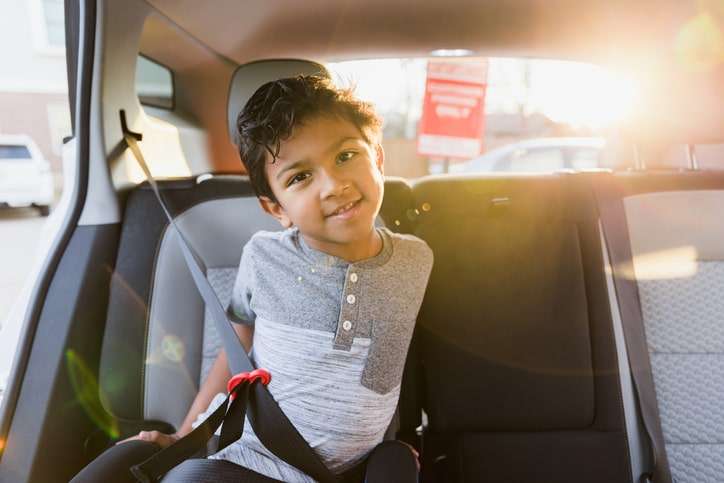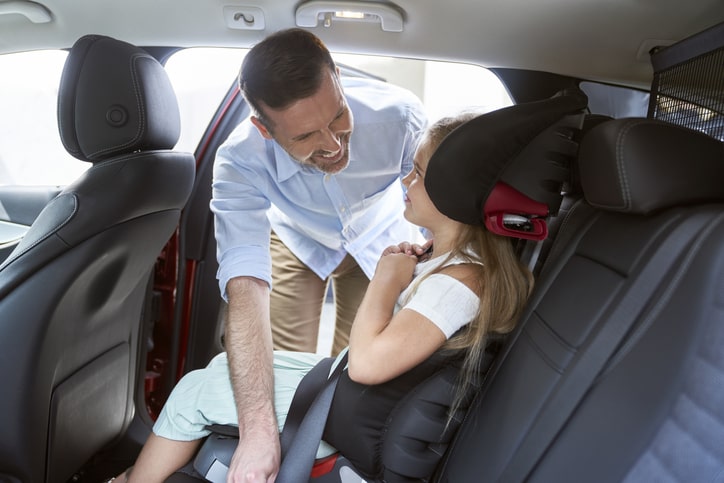When Can Kids Sit in the Front Seat of a Car? (Height & Weight)

Do you remember taking your tiny infant home from the hospital and how scary it felt to drive with them in the car for the very first time? You probably went slower around turns or triple-checked your blind spot before switching lanes. Starting at birth, parents are concerned about their child’s safety as a passenger in cars.
There are loads of rules surrounding child passenger safety, and for good reason. According to the Centers for Disease Control and Prevention, “Motor vehicle crashes are a leading cause of death among children in the United States. In 2020, 607 child passengers ages 12 and younger were killed in motor vehicle crashes, and more than 63,000 were injured.”
Car Safety Beyond the Car Seat
With babies, toddlers, and young children, many parents wonder how long you should keep your baby rear-facing in the car seat or when they can sit without a booster. However, child passenger safety doesn’t stop for adolescents.
Even when they grow out of a booster seat, your child still may not be the correct height and weight to sit in the front seat. The rules regarding child passengers in the U.S. are notoriously ambiguous and differ from one state to the next. So, we did the research to help you navigate the rules and learn once and for all when it’s safe for kids to sit in the front seat of a car.
State-Specific Child Passenger Safety Laws
It’s important to note that the car seat laws vary by state. While many only require the minimum guidelines of car seat safety, many health organizations and safety administrations recommend keeping your little one in a child restraint or in the back seat for as long as possible.
You can check your state laws on the Governor’s Highway Safety Association.
Why Do Child Passenger Safety Laws in the U.S. Vary By State?
A National Library of Medicine research article dove into the laws and federal intervention regarding child passenger safety laws. This law states:
“U.S. Congress would not likely enact federal law that regulates the behavior of vehicle operators in all 50 states. While Congress may have power to legislate such law under the Commerce Clause, it does not have the constitutional power to ‘commandeer… state legislative or executive official’ to enforce federal law.”
Therefore, each state is in charge of choosing its laws based on standards and guidelines from the National Highway Traffic Safety Association and professional associations like the American Academy of Pediatrics.
Child Passenger Safety Guidelines

Data from the CDC shows that child safety seats reduce the risk for injury in crashes by 71–82% for children and booster seat use reduces the risk for serious injury by 45% for children ages 4–8, compared with seat belt use alone. However, it’s essential to ensure you’re using the equipment correctly.
Car Seat Safety Guidelines
An infant carrier or rear-facing car seat is the first step for your baby. Even if they move out of the infant carrier and into a car seat, it should still be a rear-facing seat until they are at least two years old, but it’s recommended until four years old.
Next, children can ride in a front-facing car seat until they are at least five years old and reach the maximum height limit and weight limit of the car seat.
However, keeping them in the car seat as long as possible is the safest place. Car seats should only be placed in the back seat.
Booster Seat Safety Guidelines
Once children outgrow their forward-facing car seat, the next step is letting your child sit in a booster seat in the back seat of the car. They can move out of the booster seat when the adult seat belt fits them safely, which the CDC states is usually between ages 9 and 12.
5-Step Booster Seat Safety Test
To be sure that your child is ready to sit without a booster seat, only using a safety belt, Nationwide Children’s Hospital recommends a 5-step test. Only once can complete all five steps simultaneously is it considered safe for them to sit in the back seat without a booster.
- Have your child place their back and bottom flat against the seat of the car.
- Ensure the shoulder belt fits across the middle of the shoulder and chest.
- The lap belt must fit low across the hips.
- Their knees must bend at the edge of the seat of the car.
- Can they sit with their feet on the floor for the whole trip?
When Can Kids Sit in the Front Seat of a Car?
A common misconception parents have is thinking children are safe in the front passenger seat as soon as they no longer require a booster seat. However, the CDC states it’s safer for kids 12 years and younger to ride in the back seat.
State laws differ regarding when children can sit in the front seat of a car, with some having no instruction other than how long a child should be properly restrained. Safe Ride 4 Kids outlines specific state guidelines and how they vary from one to the next.
For example, California, Georgia, Hawaii, New Jersey, Rhode Island, and Tennessee laws require children to be in the rear seat properly restrained until age 8 but don’t specify when it’s safe for children to ride in the front seat of a car.
On the other hand, the law in Delaware doesn’t allow children to sit in the front seat until they are 12 years old or 65 inches tall, Maine law doesn’t allow children to sit in the front seat until they are 12 years of age or 100 pounds, and Washington law doesn’t allow children to sit in the front seat of the car until age 13.
Based on these recommendations, it’s safest to keep your child in the back seat until they are a teenager, but longer is always better.
Risks of Children Sitting in The Front Seat of a Car
Front-Impact Collision
The front of the car is the least safe location to ride—not just for kids, but for anyone—due to the stats regarding car accidents and front impact collisions. According to the National Highway Traffic Safety Administration, there are more front-impact collisions than any other type of crash.
In 2019, the NHTSA recorded 2.8 million front-impact collisions and 1.5 million rear-impact collisions, followed by only half a million left and right-side collisions. Putting a child in the front passenger seat at any is potentially putting them in more danger.
Airbags

In a 30-year period, the NHTSA estimates that frontal airbags have saved over 30,000 lives. While they are life-saving devices, they aren’t designed for children. In fact, airbags were tested to be safe for the average adult, which is about 150 pounds and between 5 foot 3 inches to 5 foot 11 inches.
Not many children fit into those stats. As such, a passenger airbag would likely hit a child in the face or chest, causing serious injuries, such as spinal cord injuries, whiplash, cardiac damage, and more. In fact, even the NHTSA recommends that adults sit at least 10 inches away from the airbag.
Bone Development
Even if your child is tall or heavy for their age, their bones are not developed enough to withstand the impact of an airbag. The NHTSA states that an airbag deploys in less than 1/20th of a second at extremely high speeds.
These speeds were not designed for children and could do more harm than good. From their underdeveloped spines to their growing muscles to their not-yet-developed sternum, kids aren’t equipped to handle the force of an airbag.
When Kids Think They’re Too Old For the Back Seat
While parents can easily grasp the concept, kids often aren’t interested in hearing the safety statistics or understanding the law. Some children might think they’re old enough to ride in the front passenger seat, especially if their friends are allowed to. They might argue that you’re babying them or think they’re too immature for the responsibility. While it might seem scary, the best thing you can do with your argumentative child is explain the dangers of sitting in the front passenger seat.
At their age, it’s likely they’ve already seen or heard about an awful car crash, so there’s no way to avoid the subject. Allow them to ask questions and communicate their frustrations.
However, be honest about the expectations and when they will be able to ride in the front seat of a car.

